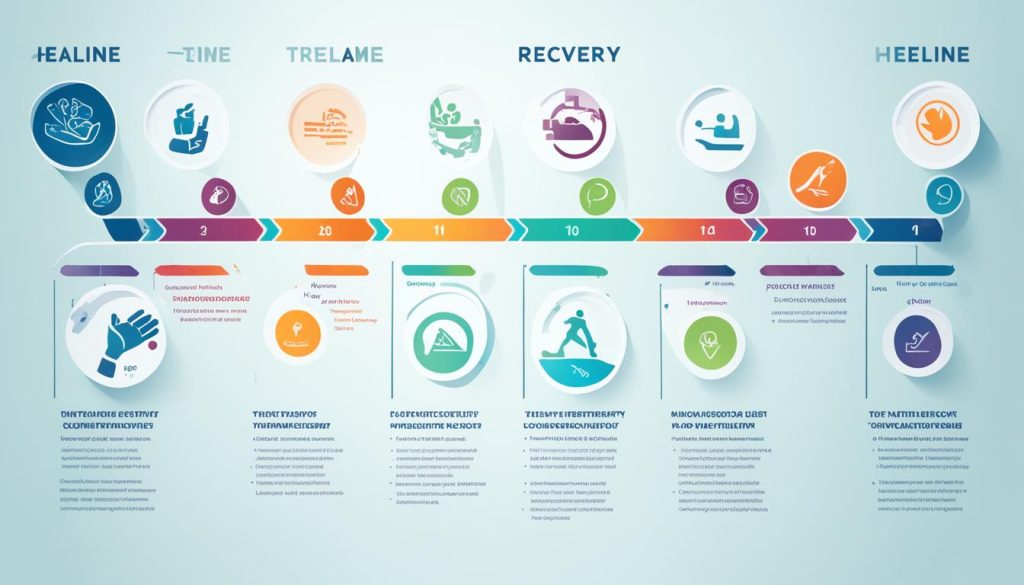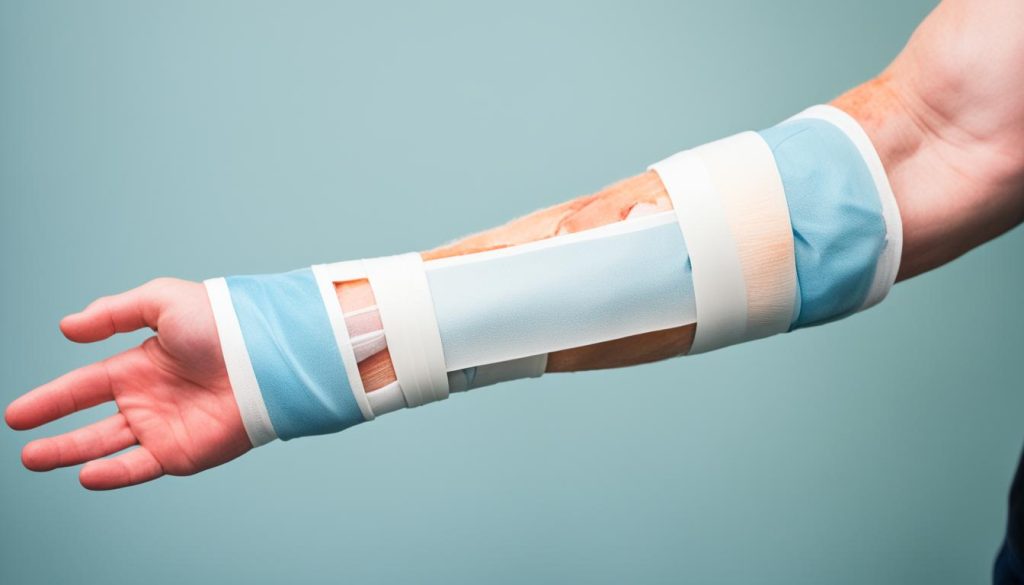A broken arm can be a painful and concerning injury, requiring proper care and time to heal. If you’ve recently experienced a fractured arm, you might be wondering how long the recovery process will take. While there is no definitive answer as the healing time can vary, there are some general timelines to consider.
On average, a broken arm takes about six weeks to heal. However, it’s important to note that this timeline can be influenced by several factors, such as the type and location of the break. Fractures involving the wrist and elbow, for example, tend to take longer to heal compared to those in other parts of the arm.
During the healing process, immobilization of the arm is crucial. This typically involves the use of a splint, brace, or cast to keep the bones in place and promote proper alignment. Immobilization helps to facilitate the healing process and minimize the risk of further injury.
In some cases, surgery may be necessary to correct severe fractures or when the bones are not healing properly. The decision to undergo surgery is made by a medical professional based on the specific circumstances of the injury.
Physical therapy is often recommended as part of the recovery process. This helps to restore functionality and strength to the arm, reducing the risk of long-term complications. The nature and extent of the fracture will determine the type and duration of physical therapy required.
It’s important to note that during the recovery period, pain and swelling are common symptoms. These can be managed with pain medications and by following the prescribed treatment plan. Regular follow-up appointments with your healthcare provider will allow for monitoring of the healing progress and adjustments to the treatment plan if necessary.
While the average healing time for a broken arm is around six weeks, complete healing can take up to 12 weeks. However, it’s important to remember that the recovery process is unique to each individual and may vary based on various factors.
If you have recently broken your arm, it’s crucial to seek professional medical advice and support. Your healthcare provider will be able to provide personalized guidance, monitor your progress, and ensure that your arm heals properly.
Stay patient and committed to your recovery plan, and remember that with time and proper care, you will be on the path to a full recovery.
How Long Does it Take a Broken Arm to Heal?
Factors Affecting Recovery Time for a Broken Arm
The recovery time for a broken arm can be influenced by several factors. One of the key factors is the type and location of the break. Fractures involving the wrist and elbow generally take longer to heal compared to those in other parts of the arm. This is because these joints are more complex and have more interconnecting bones, ligaments, and tendons.
Another factor that can affect the recovery period is additional injuries or complications. For example, if the broken arm is accompanied by damage to nerves, blood vessels, or surrounding soft tissues, the healing process may be prolonged. In some cases, fractures may require surgical intervention, which can also extend the recovery time frame.
It is crucial to follow the doctor’s recommendations and attend regular check-ups to monitor the healing progress and identify any potential complications. By closely adhering to the prescribed treatment plan, including immobilization, physical therapy, or surgical intervention, you can optimize your chances of a successful and timely recovery.
Recovery Time Frame for Different Types of Breaks
| Type of Break | Average Healing Time |
|---|---|
| Simple fracture | Approximately 6-8 weeks |
| Compound fracture | Longer recovery period, ranging from 8-12 weeks |
| Hairline fracture | Usually heals within 4-6 weeks |
| Stress fracture | Recovery time can take between 4-12 weeks |
These are general guidelines, and each individual’s healing process may vary. The severity of the break, the overall health and age of the patient, and the presence of any underlying medical conditions can also impact the recovery period.
To ensure a smooth recovery, it is essential to be patient, attentive to your body’s signals, and seek professional medical advice and support. By following the recommended treatment plan and taking the necessary steps for healing, you can expect to regain full strength and functionality in your arm within the expected time frame.

Treatment Options for a Broken Arm
When it comes to treating a broken arm, the approach may vary depending on the specific damage and severity of the fracture. Here, we discuss some common treatment options that aim to facilitate healing and restore functionality to the affected arm.
1. Immobilization
Immobilization is often the initial step in treating a broken arm. It involves the use of a splint, brace, or cast to restrict movement and provide support to the fractured bones. Immobilization helps align the broken bones properly, reducing pain, and allowing for natural healing to occur. The duration of immobilization may vary depending on the complexity of the fracture and the individual’s healing progress.
2. Surgery
In cases where the fracture is severe or does not heal properly with other treatment methods, surgery may be necessary. Surgical intervention aims to realign the broken bones using screws, plates, or rods. It provides stability and promotes optimal healing. The decision to undergo surgery is determined by the doctor based on the specific circumstances of the fracture.
3. Physical Therapy
Physical therapy plays a crucial role in the rehabilitation process after a broken arm. Once the fracture has sufficiently healed, physical therapy is recommended to improve strength, flexibility, and range of motion in the affected arm. A personalized exercise program is designed by a physical therapist, taking into account the location and severity of the fracture. The exercises may involve stretching, strengthening, and gradually increasing the intensity of movements to regain functionality.
While these treatment options are commonly employed, the specific approach may vary depending on the individual case. It is important to consult with a healthcare professional to determine the most suitable treatment plan based on the nature of the fracture and other individual factors.

| Treatment Options | Benefits | Considerations |
|---|---|---|
| Immobilization (Splint, Brace, or Cast) |
|
|
| Surgery |
|
|
| Physical Therapy |
|
|
Healing Stages and Timeline for a Broken Arm
The healing process for a broken arm can be divided into several stages, each playing a crucial role in the complete recovery of the injury. Understanding these stages can provide insight into the average healing time for a broken arm and what to expect during each phase.
Stage 1: Initial Healing Phase – Pain, Swelling, and Nerve Formation
The initial stage of healing for a broken arm is characterized by pain, swelling, and the formation of new nerves. During this phase, it is essential to prioritize immobilization and rest to minimize discomfort and allow the fractured bones to begin the healing process. The duration of this stage can vary depending on the severity and location of the fracture.
Stage 2: Tissue Repair and Fracture Callus Formation
In the second stage, the focus shifts to tissue repair and the formation of a fracture callus. This callus is made up of fibrous tissue, cartilage, and bone fragments that bridge the gap between the broken bone ends. During this stage, X-rays may reveal visible calcium deposition in the callus formation, indicating progress in the healing process.
Stage 3: Remodeling – Replacing the Fracture Callus with Organized Bone
The final stage of healing is remodeling, where the fracture callus is gradually replaced with organized bone. This stage is crucial for restoring the strength and integrity of the broken arm. While the complete healing of a broken arm can typically take up to 12 weeks, it’s important to note that full strength may not be restored for up to two years in some cases.
Throughout the healing stages, it’s important to follow the prescribed treatment plan, including immobilization, physical therapy, and regular check-ups with the healthcare provider. These measures ensure proper healing and minimize the risk of complications. Each individual’s healing timeline may vary, depending on factors such as age, overall health, and the specific characteristics of the fracture.

Conclusion
Recovering from a broken arm requires time, patience, and adherence to the prescribed treatment plan. The duration of broken arm recovery can vary depending on various factors, such as the type and location of the fracture. The healing timeline for a fractured arm typically ranges from six to twelve weeks, but individual experiences may vary.
Following the doctor’s instructions is crucial for a successful recovery. This includes attending physical therapy sessions, which play a vital role in restoring functionality and strength to the arm. Additionally, monitoring for any complications is essential to ensure proper healing and prevent long-term issues.
It’s important to note that some individuals may experience chronic pain or complications that require additional treatment even after the initial recovery period. If you are currently in the process of recovering from a broken arm, it is highly recommended to seek professional medical advice and support to ensure proper healing and restoration of function.




